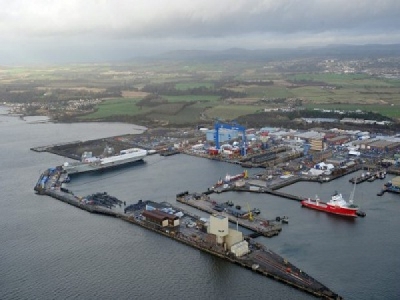
Posted on February 16, 2017
By Leeza Clark and Jonathan Watson, The Courier
Developing Rosyth’s international container port is a potential step change for the Scottish economy, according to a leading Fife politician.
Babcock is currently seeking contractors for the initial stages of the ambitious £85 million project, recognised in the Scottish Government’s national planning framework 2.
That set out a vision for Scotland for 2030 and listed major projects identified by the Scottish Government as of vital national significance.
The list also included a new road bridge across the Forth — the Queensferry Crossing is on schedule to open this May.
Depute Fife Council leader Lesley Laird said: “The regeneration of Rosyth Waterfront remains a key priority for Fife Council and we have committed to work in partnership with the three principal landowners in promoting the unique capabilities of the area known as Gateway Rosyth.
“The development of the Rosyth international container terminal is potentially a step change project for both Fife and indeed Scottish economies and we welcome another milestone in the project with progression of the marine licence from Marine Scotland dredging and construction activities.”
Mrs Laird, who is the council’s economy and planning spokeswoman, said the local authority is continuing its discussions with Babcock International in ensuring that Fife’s businesses can benefit from the development where possible, including possible expansions of the region’s rail network.
With strong campaigns for a new railway line at Levenmouth and a Scottish Transport Appraisal Guidance (STAG) study underway for a Dunfermline to Alloa link, she added: “We are looking to see development and investment in Fife’s rail network and with our support of the Levenmouth Rail Link, the STAG for the Dunfermline-Alloa line and the Dunfermline rail halt, we will naturally want to explore other opportunities that this project may bring such as the greater use of the rail line into the port area.”
Mrs Laird’s words come as Babcock, the dockyard operators, seek to appoint contractors for the first, £38 million phase of the enormous project.
Expected to create hundreds of jobs, new quay walls need to be designed and constructed, while an approach channel needs to be dredged to allow construction work on the terminal to be carried out.
The complex is to be created at a site once part of the 1990’s RD57 project, an area at the dockyard where Trident nuclear submarines were to be refitted.
However, the site has been dormant for more than 20 years after the contracts were awarded to the Navy’s base at Devonport in Plymouth instead.
Once completed, the terminal will be able to receive thousands of shipping containers from around the world and result in a dramatic increase in industrial shipping using the Firth of Forth.
A Babcock spokesperson said: “As part of the necessary regulatory requirements, Babcock is currently in an application process with Marine Scotland to be able to undertake Dredging and Marine Construction work in advance of the development of the Rosyth International Container Terminal.
“The new facility is planned to enhance the current infrastructure at Babcock’s Rosyth facilities and will represent an important investment in the economy of Fife.”
Waterfront remains strategic site
Ambitious plans for the Rosyth Waterfront were dealt a blow late last year when a recommendation in the long awaited Fifeplan said land at the waterfront should not be zoned for mixed use but should be kept solely for industrial use.
That effectively left the Scarborough Muir Group’s £500 million vision for a dynamic quayside development featuring bars, restaurants and new housing dead in the water.
Council leader David Ross vowed to fight the controversial decision, stressing the waterfront remained a strategic site with the potential to provide a significant number of new jobs.
RD57
It was back in the late eighties that a hole the size of six football pitches was dug at Rosyth.
While it was officially called RD57, the local wags soon dubbed it “the hole that cost a mint”.
Millions was spent on it as anticipation rose this was where Trident would be refitted.
But controversially the contract to refit the nuclear submarine fleet was switched to Devonport.
The Westminster Government handed the £5 billion contract to the southern base in 1993 — and the massive unused dry dock was left unused.
Source: The Courier





